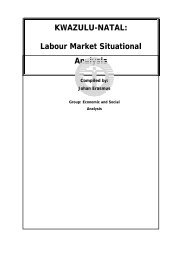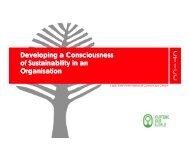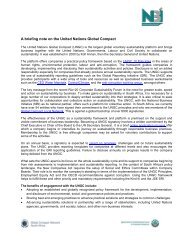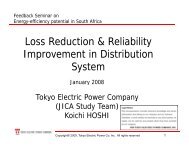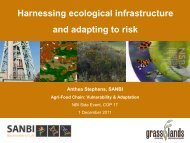Sustainable Forest Finance Toolkit - PwC
Sustainable Forest Finance Toolkit - PwC
Sustainable Forest Finance Toolkit - PwC
- No tags were found...
Create successful ePaper yourself
Turn your PDF publications into a flip-book with our unique Google optimized e-Paper software.
Appendix 1: Special places 1 of 3Definitions related to special places.Developed by Definition Characteristics Management preferences NotesAlliance for ZeroExtinction (AZE)AZE sites (AZE, 2007)Focus on sites in most urgent need of conservation to prevent speciesextinctions. Priority sites must meet the three following requirements:• Endangerment – at least one endangered or critically endangeredspecies listed by IUCN.• Irreplaceability – the area contains the overwhelmingly significant knownresident population of the endangered or critically endangered species, orit contains the overwhelmingly significant known population for one lifehistorysegment of the species.• Discreteness – the area has a definable boundary within which thehabitats, biological communities, and/or management issues have morein common with each other than they do with those adjacent areas.Management for conservation.A global joint initiative of 52 biodiversityconservation organisations. Alliance membersinclude BirdLife International, ConservationInternational, Wildlife Conservation Society, andWorld Wildlife Fund US. 595 sites around theworld have been identified to protect 794species of mammals, birds, reptiles, amphibiansand conifers.American Tree FarmSystem (ATFS)Special sites (AFF,2004)Sites of special interest because of their recreational, historical, biological,archaeological and geological features.To the extent practicable,management practices shouldprotect these sites.Special sites can be identified directly on theground by landowner and an ATFS inspectionforester.ConservationInternationalBiodiversity hotspots(ConservationInternational, 2007)Hotspots are priority global areas for conservation. Hotspots arecharacterised by exceptional levels of plant endemism (at least 1,500species of vascular plants) and by serious levels of habitat loss (lost atleast 70% of its original habitat). Worldwide, 34 biodiversity hotspots havebeen identified. Collectively, these hotspots are estimated to house highlevels of biodiversity, including at least 150,000 plant species asendemics and 77% of the world’s total terrestrial vertebrate species.Conservation can be carriedout through a variety ofapproaches, including theestablishment of protectedareas and the implementationof economic alternatives.Conservation outcomes identified for individualhotspots are defined through regional-scaleplanning processes; maps of biodiversityhotspots and species databases are availableat www.biodiversityhotspots.org.ConservationInternationalMajor tropicalwilderness areas(Mittermeier et al., 2001)A complementary concept to the biodiversity hotspots, the major tropicalwilderness areas have high diversity and endemism, low humanpopulation density, and remain largely intact.Conservation can be carriedout through large scaleconservation set-asides.Include the Guyana Shield region (Suriname,Guyana, French Guiana, Venezuela andadjacent parts of Brazil), the upper Amazonian(Brazil, Colombia, Ecuador, Peru and Bolivia); asubstantial portion of the Congolese forestsblock/Congo River Basin in Central Africa; andmost of the island of New Guinea and adjacentsmaller Melanesian islands (Solomon Islands,New Britain, New Ireland and Vanuatu).Page 81pwc



